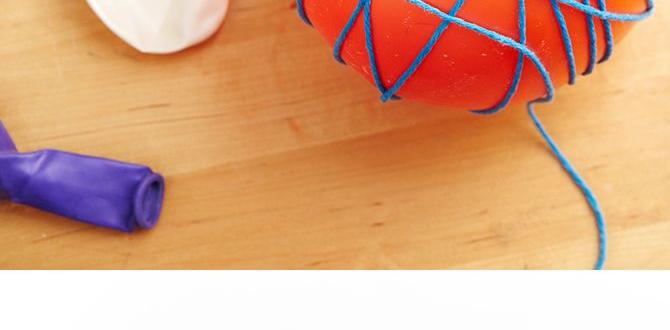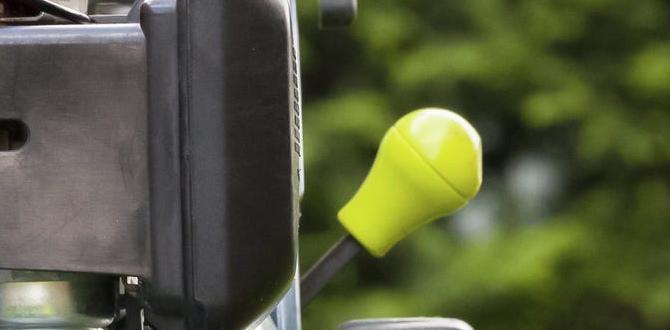For a smooth, professional shiplap finish, the right nail gun makes all the difference. The best nail gun for shiplap typically is a brad nailer or a finish nailer, offering the control and finesse needed for thin wood. Look for models that shoot 18-gauge nails, balance well, and have adjustable depth settings for perfect countersinking without damaging the tongue-and-groove. Your shiplap project will be faster and look better!
Hey there, DIYers! Jack Shaffer, Nailerguy, here. Installing shiplap can seem daunting, but with the right tools, it’s surprisingly straightforward and immensely satisfying. You know that beautiful, rustic charm shiplap brings to a room? Getting those clean lines and secure boards can feel like a puzzle, especially if you’re new to using nail guns.
Many beginners worry about damaging the wood, over-driving nails, or just not getting a strong hold. The good news? Choosing the right nail gun for your shiplap project takes away most of that stress. It’s all about understanding what works best for this specific type of molding.
In this guide, we’ll walk through exactly what makes a nail gun ideal for shiplap and help you pick the perfect one for your home project. We’ll dive into the types of nailers, essential features, and even look at a few top contenders. Let’s get your walls looking fantastic!
Table of Contents
Why a Nail Gun is a Game-Changer for Shiplap
When you’re putting up shiplap boards, you’re dealing with pieces of wood that need to be secured firmly and discreetly. While a hammer and finishing nails might seem like the traditional route, a nail gun offers several significant advantages, especially for beginners.
- Speed: Nail guns drive nails in a fraction of a second, allowing you to install boards much faster than with a hammer. This is a huge time-saver for large wall areas.
- Consistency: They deliver nails to a consistent depth every time, creating a clean, professional look. You won’t have nails sticking out or sunk too deep.
- Reduced Fatigue: Repeatedly swinging a hammer can be tiring. A nail gun requires a lighter touch, reducing strain on your arms and wrists.
- Damage Control: You can set the depth precisely, ensuring you don’t split delicate wood or leave unsightly marks on the surface of your shiplap boards, which are often thin.
Choosing the Right Nail Gun for Shiplap: The Key Features
Not all nail guns are created equal, and for shiplap, you need something specific. We’re looking for precision, control, and the ability to handle thinner materials without causing damage. Here’s what to consider:
Gauge Matters: Why 18-Gauge is Your Go-To
The “gauge” of a nail gun refers to the diameter of the nails it fires. The smaller the gauge number, the thinner the nail. For shiplap, you generally want an 18-gauge nailer.
- 18-Gauge Brad Nailer: These are the workhorses for shiplap. They fire thin, relatively short nails (typically 1 to 2 inches long) that leave a very small hole, making them easy to conceal with wood filler or caulk. They provide enough holding power for most interior shiplap applications without splitting the wood.
- Avoid: Finer gauges like 20 or 23 gauge (micro pinner) might be too delicate, offering insufficient holding power. Larger gauges like 16-gauge finish nailers or framing nailers are overkill and will leave larger, more noticeable holes.
You’ll find that 18-gauge nails are strong enough to hold the shiplap boards securely to the wall studs, but thin enough that the entry point is minimal and hides away nicely once you’re done.
Power Source: Corded, Cordless, or Pneumatic?
Nail guns come in three main power types. Each has its pros and cons, especially when it comes to shiplap installation which often requires moving around a lot.
| Type | Pros | Cons | Best For Shiplap? |
|---|---|---|---|
| Pneumatic (Air-Powered) | Powerful, lightweight gun, generally less expensive initial tool cost, quiet operation (gun itself). | Requires an air compressor and hose, limiting mobility. Compressor can be bulky and noisy. Need to manage air pressure. | Good if you have a compressor and are working in a fixed area. Less ideal for large rooms or frequent repositioning. |
| Cordless (Battery-Powered) | Highly portable, no hoses or compressors needed, easy to set up and use anywhere. Many models are “jobsite ready.” | Can be heavier due to the battery, initial cost can be higher, battery life may be a concern for very long jobs. Nail driving power can vary by model. | Excellent for shiplap. Offers great freedom of movement, which is crucial when working along walls. |
| Corded Electric | No fuel or batteries to worry about, usually more affordable than cordless. Simple to operate. | Tethered by a power cord, which can be a tripping hazard and limits mobility. May have less power than pneumatic or high-end cordless. | Okay for smaller shiplap projects in areas with easy power access. The cord can become a nuisance when covering large wall areas. |
For shiplap, especially if you’re tackling a whole room or multiple walls, a cordless battery-powered nailer is often the most convenient choice. The freedom from hoses and compressors significantly speeds up the process and makes navigating around the room much easier.
Adjustable Depth Control: Precision is Key
This is a critical feature for shiplap. You want to set the depth so the nail head sinks just below the surface of the wood (countersunk) but doesn’t break through the thin veneer or create a large divot.
- Why it’s important for shiplap: Shiplap boards are typically thin. Overdriving a nail can split the wood or leave a hole that’s too deep to easily fill. Undriving leaves a nail head proud of the surface, which you’ll then have to hammer down, potentially damaging the board.
- Look for: A tool-free depth adjustment knob or lever. This allows you to quickly make micro-adjustments as you work with different types of shiplap or on various surfaces.
Sequential vs. Bump Fire Trigger
Nail guns have different trigger modes:
- Sequential (or “single shot”): You must sequentially press the safety contact tip against the surface AND pull the trigger to fire one nail. This is the safest mode, especially for beginners and delicate work like shiplap. It prevents accidental nail firing.
- Contact (or “bump fire”): You can hold the trigger down and “bump” the safety contact tip against the wood to fire nails rapidly. This is much faster but requires more practice and can lead to accidental firing if you’re not careful.
For shiplap installation, where precision and control are paramount, a sequential trigger is highly recommended for beginners. It ensures you place each nail exactly where you intend it.
Ergonomics and Weight
You’ll be holding the nail gun for extended periods, often overhead or in awkward positions. A tool that is too heavy or uncomfortable can lead to fatigue and mistakes.
- Test it out if possible: See how it feels in your hand. Does the grip feel good? Is the weight balanced?
- Consider: Lighter models, especially cordless ones, make a big difference during a long installation day.
Top Nail Gun Recommendations for Shiplap
Based on the features discussed, here are a few types of nail guns that generally perform excellently for shiplap installations. Remember to always check the specific model’s capabilities and reviews!
1. The Versatile Cordless 18-Gauge Brad Nailer
This is the most popular choice for a reason. It balances power, portability, and the precision needed for decorative trim work like shiplap.
- Why it’s great: No compressor needed, easy to set up, and lightweight enough for comfortable extended use. The 18-gauge size is perfect for shiplap.
- Key Features to look for: Adjustable depth control, tool-free jam release, good battery life, and a sequential firing mode.
- Popular Brands (examples): Ryobi ONE+, Dewalt 20V MAX, Milwaukee M18 FUEL, Metabo HPT (formerly Hitachi).
2. The Budget-Friendly & Reliable Pneumatic 18-Gauge Brad Nailer
If you already own an air compressor or are looking for a more budget-friendly entry into nail guns and don’t mind managing hoses, a pneumatic option is solid.
- Why it’s great: Often less expensive than cordless equivalents, and the gun itself is typically lighter and more compact.
- Key Features to look for: Integrated air pressure regulator on the compressor, trigger type (sequential recommended for beginners), and overall build quality.
- Consideration: The need for an air compressor and hose adds to the overall cost and complexity of setup/transport. Ensure your compressor can maintain consistent pressure.
3. The Premium Option: High-Performance Cordless
For professionals or serious DIYers looking for the best performance and durability, higher-end cordless models offer excellent power and features.
- Why it’s great: Superior nail penetration, often more robust build quality, and longer battery runtimes.
- Features: Advanced battery technology, improved ergonomics, and sometimes specialized modes for different materials.
- Brands: Brands like Senco, Bostitch, and higher-tier models from Dewalt and Milwaukee often fall into this category.
Essential Accessories and Supplies
Beyond the nail gun itself, you’ll want a few other things to ensure your shiplap installation goes smoothly and looks professional.
- Nails: Make sure you buy 18-gauge brad nails of the appropriate length for your shiplap thickness. Most shiplap will use 1 1/4″ to 2″ nails. Always use nails recommended by the nail gun manufacturer to avoid jams and ensure proper function.
- Air Compressor & Hose (if pneumatic): If you go with a pneumatic nailer, you’ll need a compressor that can put out at least 90 PSI (pounds per square inch) and a suitable air hose. A common size for DIYers is a 6-gallon portable compressor. For guidance on air compressors, resources like OSHA’s safety regulations related to compressed air tools can be informative regarding safe usage.
- Safety Glasses: This is non-negotiable! Always wear safety glasses or goggles when operating any power tool, especially nail guns.
- Hearing Protection: Nail guns can be loud, so earplugs or earmuffs are a good idea.
- Wood Filler or Caulk: For filling nail holes and sealing gaps.
- Stud Finder: Crucial for locating wall studs to ensure you’re anchoring your shiplap boards effectively.
- Level: To ensure your boards are installed straight.
- Measuring Tape and Pencil: For precise cuts and placement.
Step-by-Step: Installing Shiplap with Your Nail Gun
Let’s get to it! Here’s a general process for installing shiplap using your chosen nail gun. Always refer to your specific shiplap product’s instructions and your nail gun’s manual.
Step 1: Plan and Prepare Your Wall
Measure and Mark: Determine where your shiplap will start and end. Use a level to draw a faint, straight line if needed, especially for the first board. Mark the locations of wall studs using a stud finder. This is vital for secure installation.
Gather Tools: Have your nail gun, nails, safety gear, measuring tape, pencil, and level ready.
Acclimatize Wood: Let your shiplap boards sit in the room for a few days to adjust to the humidity and temperature. This prevents excessive expansion or contraction after installation.
Step 2: Prepare Your Nail Gun
Load Nails: Open the magazine of your nail gun and insert a strip of the correct size and type of 18-gauge nails. Make sure they are seated properly.
Check Power: If cordless, ensure your battery is charged. If pneumatic, connect the air hose and set your compressor to the recommended pressure (usually around 70-100 PSI, check your nailer’s manual).
Set Depth: Before firing into your actual shiplap, test the depth on a scrap piece of the same material. Adjust the depth setting until the nail head countersinks perfectly—just below the surface.
Select Trigger Mode: Ensure your nail gun is set to sequential fire mode for safe, controlled nailing.
Step 3: Install the First Board
Position: Place your first shiplap board against the wall. Use your level to ensure it’s perfectly straight. Hold it firmly in place.
Nail into Studs: Place the tip of the nail gun against the board where it will overlap with a stud. Press the tip firmly against the wood (this engages the safety contact) and then pull the trigger. You should hear a satisfying “thwack!” and the nail will be reliably driven.
Secure Placement: Drive nails along the length of the board, spaced about 16 inches apart, directly into the marked stud locations. For DIY shiplap with a groove and tongue system, you can often nail through the difficult-to-see “tongue” part of the board, or along the edge of the board where it will be covered by the next piece. This makes the nails less visible.
Step 4: Continue Installing Subsequent Boards
Interlocking: Slide the groove of the next board over the tongue of the previously installed board. Ensure a snug fit.
Nail: Repeat the process of positioning the nail gun, pressing firmly, and pulling the trigger. Nail into studs wherever possible. For boards that don’t land directly on a stud, you might need to place a nail closer to the edge depending on your shiplap system and desired strength. Always aim for the thickest part of the wood where possible.
Maintain Consistency: Try to keep your nailgun angle consistent to ensure the nail enters the wood straight.
Step 5: Nailing Around Obstacles
Windows and Doors: You may need to cut boards to fit. For these areas, careful measurement and precise nailing are key. You might have to nail at an angle or into shorter blocking you’ve added.
Electrical Outlets: Be extremely careful around electrical boxes. You may need to cut specific shapes or use a smaller nailer adapter if your gun has one. If unsure, consult a qualified electrician or refer to U.S. Department of Energy resources on building and renovation best practices for safety and efficiency.
Step 6: Finishing Touches
Fill Holes: Once all boards are installed, use a good quality wood filler or caulk to fill any nail holes. Let it dry and then sand it smooth for a seamless look.
Caulk Seams: Apply caulk along the top and bottom edges of your shiplap, and any seams, for a clean, finished appearance.
Paint or Stain: Apply your chosen finish!
Troubleshooting Common Shiplap Nail Gun Issues
Even with the best tool, occasional hiccups happen. Here’s how to deal with them:
- Nail Jam: This is the most common issue. First, ALWAYS disconnect the power source (battery or air hose) and remove the battery/release air. Then, consult your nailer’s manual to release the jam. Often, it involves opening the magazine or nose of the tool.
- Nails Not Firing: Check the power source. Is the battery charged? Is the air pressure sufficient? Is the safety contact tip fully depressed? Are there any nails jammed in the feed mechanism?
- Nails Not Driving Deep Enough: Increase the air pressure (for pneumatic) or adjust the depth setting if your tool has one that controls power indirectly. Ensure



